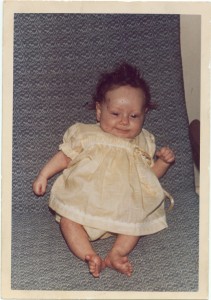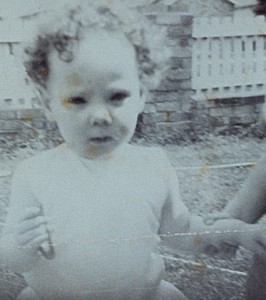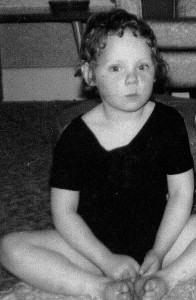Rickets, vitamin D deficiency and autism
 I have childhood photos indicating Rickets from as young as 5 months old. Ricket’s shows itself in the forehead, bulges at the wrists, banana shaped bowed arms and legs and distended belly. But this severe vitamin D deficiency has more extensive impact than just bone development. It impacts the entire immune system, later teeth development, the muscles, the spleen, the liver, the gut, and the nervous system – yes, the brain.
I have childhood photos indicating Rickets from as young as 5 months old. Ricket’s shows itself in the forehead, bulges at the wrists, banana shaped bowed arms and legs and distended belly. But this severe vitamin D deficiency has more extensive impact than just bone development. It impacts the entire immune system, later teeth development, the muscles, the spleen, the liver, the gut, and the nervous system – yes, the brain.
Almost eradicated in the 1940s with the use of cod liver oil given to children and encouragement to get out in the sun and play, it was so rare in the 1960s, when I had it, that when my two cousins had it apparently made the papers. My own case didn’t but I expect it drew attention from the GP and welfare services and had some relationship to me being taken into a welfare centre program for at risk children from 6mths old until I was 2 and a half.
I had apparently had jaundice at 6 months old (you can see I’m ‘tanned’ in the pic at 4mths old, in fact I’m actually a very pale person and don’t tan) and colic and recurrent infections but I was never told about the Rickets. Probably because in the 1960s such cases would instantly have flagged ‘neglect’. By 2 and a half I had spent my weekdays being fed and in the sunshine of Northcote Day Nursery (at that time, 1965, it was a welfare program for at risk children, today it is a regular nursery) so if Rickets had merely been an episode in my infancy then all that should have remained would have been the bone deformities.
But at 2 and a half I was in a three day hospital assessment at St Elmo’s hospital. According to my father and my aunt, I was there primarily because of queries as to whether I was deaf or had leukemia (as I didn’t respond and had easy bruising, bleeding gums and my eyelashes coming out). The result was I was diagnosed as psychotic, infantile psychosis, which is what autism was considered to be in the 1960s. Was Rickets unrelated?
According to my father and aunt there were other developmental delays. I struggled to stand or walk (not surprising with Rickets) but was also late with toileting, which I managed by the age of 3 and a half. I remember I had shoes I knew as ‘click clacks’ from the sound they made. I had them from around age 4 to 6. They were heavy leather school shoes with press down ‘caliper’ style metal buckles that didn’t leave any room for my feet to twist. Not sure what did the trick but I obviously came to walk fine.
The developmental issues went together with physical health issues. I remained on fairly constant antibiotics for recurrent infections and as an adult was diagnosed with the primary immune deficiencies, food allergies and food intolerances I’d apparently had all my life.
The Q angle of my knees in the above picture was 25 degrees. The normal Q angle for a female child aged 7-8 is 7-11 degrees.
At age 9 my teeth were horrendous and I required fillings to most of my teeth. My mother was told that I would probably have false teeth by adulthood and that I had a calcium metabolism problem. She, herself, would tell people that when pregnant with me she had lost all her teeth so there may have been some truth in this. With her being an alcoholic when I was born, she was likely already D or calcium deficient but its equally possible that with two cousins developing Rickets in the 60s when I also did that it may have been more than just us both being born to alcoholic mothers. They may well have already had their own metabolic disorders. With being on supplements since age 9-11 I got to keep my teeth into adulthood though they were yellow and pitted and so I have veneers covering them top and bottom so instead they present a ‘picture of health’.
At age 9, I was the second shortest girl in the school. I may have been 3ft 3″ as I remember being 3ft 3″ in grade 3, so 39 inches, the average being 47. So was put on zinc, C, multivitamin-minerals. As a result of grew to 61 inches (5ft 1″) by age 12 with associated severe bone and joint pain. and was put onto zinc, vitamin C and multivitamin-minerals and three years later I was normal height at 5ft 1″ but with all the expected severe growth related pains of sped up sudden growth. I was also diagnosed with language processing disorder and the treatment of me changed accordingly and the combination of the nutritional interventions and communication interventions meant that by age 9-11 I went from 90% meaning deaf to only 50% meaning deaf and moved accordingly from echolalia to producing progressively functional communication. I had been put through intensive ballet training from age 5
to age 9 which hopefully improved bone strength for me but it certainly train me to support my spine with well developed thigh and lumbar muscles and taught me to turn my legs out which hid my now longer bowed legs. With spinal degeneration in my 40s, I’m glad of the supplements and ballet that might otherwise see me now with a far higher level of issues than I’m tackling.
As an adult I was diagnosed with a range of food allergies and intolerances, among which was casein intolerance. Had I been unable to digest cow’s milk in infancy (I was left with cow’s milk bottles, not breast fed) this may well have as easily contributed to my Rickets as having been reportedly left in my bedroom for my first 6 mths, so without adequate sunshine.
In spite of inability to have milk products, in adulthood, I had a diet that was rich in D and calcium and was perplexed that in spite of being on fish oils, eating chicken and fish and spending adequate time in the sun daily without a hat or suncream that I was D deficient. I went on to vitamin D drops and this normalised in my next blood results by the time I was diagnosed with breast cancer.
My case is only an anecdotal one but an extensively documented one nevertheless. Rickets, once an eradicated disease in modern societies is now back in epidemic proportions thanks to over zealous reactions to fear of skin cancer and lifestyle changes. Children who were once playing out in the sun without hats or sunscreen, play indoors or under sun shades whilst slathered in sunscreen. Children now rarely play in the street or walk to school.
Sure, skin cancer is real, but most skin cancers are basal cell carcinoma, essentially cosmetically harrowing but won’t kill you, squamous cell cancers generally start as harmless solar keratoses that are commonly picked up and gotten rid of before they develop into potentially deadly squamous cells, and melanoma, undoubtedly deadly, accounts for only 6% of skin cancers. Other allergies, immune problems, life long back pain and spine degeneration. Sometimes we need to get the overview, not fixate on a single detail. Its about balance.
With advancements in the study of the health issues of children with autism, new studies are finding a range of gut, immune, metabolic anomalies related to developmental delay and associated neurological, sensory perceptual, sensory integration, communication and motor planning development issues. Combine this with a set of personality traits predisposing a child to respond ‘autistically’ to chronic stress, disability or information overload and once those responses have become neurologically patterned, automatic and integrated into the child’s identity, strategies, adaptations and responses to the environment by age 3-5 and you may well have a recipe for a presentation and diagnosis of autism.
An article in The British Medical Journal, Vol 1, N.o 1379, in 1887 (yes, I did mean 1887, not 1987) mentioned impact of Rickets not only on bone development but on ‘derangements’ of the spleen, liver, heart and digestive system and urged for medicine to not overlook the neurological impacts of Rickets reported as far back as the mid 1800s, which included epilepsy (seizures, including absence seizures that may look like staring spells), Hyperesthesia(multiple sensory hypersensitivities), muscle weakness, tentany(causes involuntary muscle contractions and twitches) and ‘mental backwardness'(ie developmental delay, information processing disorders and learning disability).
It was still being discussed in 1939, 4 years before Kanner would coin the term ‘autism’. To quote from a recent article in Psychology Today:
“To my knowledge, the neuropsychiatric symptoms of rickets have not been studied in the modern era. However, at least two old papers have addressed it, both published before Kanner described autism in 1943. Both papers describe ‘weak mindedness,’‘feeble minds,’‘mental dullness,’ unresponsiveness and developmental delays. Even more intriguing, both papers report that the mental condition in rickets improved with vitamin D.”
you can read the whole article article“>here.
Whilst vitamin D levels are essential to normal brain development, the brain’s development, resilience and nutrition also depend on the gut (colon), immune, detox (kidney), blood sugar balance and enzyme production (pancreas).
“The VDR (vitamin D receptor) is present not only in tissues that regulate serum calcium, including the small intestine, bone cells, and kidney, but also in essentially all tissues and cells in the body, including brain, colon, breast, prostate, pancreas, heart, skin, skeletal muscle, monocytes, and activated T and B lymphocytes (essential parts of immune system function)” (1, 20–22, 24). http://www.jci.org/articles/view/29449
With the near eradication of Rickets in developed countries by the 1940s, all this history of knowledge and its potential relevance to autism was probably lost until around the 1970s skin cancer campaigns added lack of sun exposure to the lives of children who had never “done” cod liver oil as grandmothers had, often with dread and off the spoon, in the 1940s and 50s.
Today premature babies who would have died in the old days of daily cod liver oil, commonly survive. Yet many are born with D deficiency and in spite of this are given heavy vaccination regimes that such an undeveloped, unregulated immune system would perhaps be far more at risk of being overwhelmed by. Vitamin D deficiency impairs glutathione metabolism, which is essential for detox function. In a more heavily polluted society than in the 1940s and 50s, those with D deficiency could today more easily become further neurologically compromised through toxins they can’t detox from heavy metals and other toxins (probably including salicylate, a natural plant toxin) at the rate of most children.
Add to this a lack of breast feeding, lack of good bacteria in our now pasteurized milk and plants selectively bred to have higher and higher levels of the natural plant toxin, salicylate (because it deters insect attack) and you have a range of further exacerbation to gut and immune health in what may already compromised child. Seems that even breast feeding may not provide adequate vitamin D levels without supplementation either! Then there’s the question of no standard testing of infant’s ability to digest lactose or casein so those who would also be at risk of Rickets that could be picked up before it wreaks havoc. There is also subclinical Rickets and inherited causes of Rickets.
The physical signs of autism are already widely noted and the similarities with vitamin D deficiency in Rickets are very strong. The differences may well reflect some of the additional flow on effects of D deficiency in our modern society. We have more polluted, toxin loaded, highly vaccinated, and more sunshine depleted infancies since the 1970s-80s sun phobic modern world than those writing about Rickets in the 1940s could have imagined.
But if children with autism had Rickets wouldn’t they all show the bone deformities so obvious in those with Rickets? It’s a great question. But keep in mind that gestational Rickets (during the mother’s pregnancy) means the fetus is still floating in fluid in the mother’s womb. The fetus has not yet sustained weight on their legs and the gravity effecting the arms in children with Rickets may be completely different whilst one has only ever floated, essentially weightless in fluid. What about the forehead? Do children with autism tend to have the protruding forehead seen in children with Rickets and associated with scull formation? The answer is, yes, people have noted this, particularly in Fragile X, one of the most common forms of autism. The flat feet in Fragile X is also a known sign of vitamin D deficiency. Large heads seen in people with autism also occurred in children with Rickets (known as rickety children) as per the following text from the mid 1800s:
“Scrofulous and rickety children are the most usual sufferers in this way. They are generally remarkable for large heads, great precocity of understanding, and small, delicate bodies. But in such instances, the great size of the brain, and the acuteness of the mind, are the results of morbid growth. Even with the best of management, the child passes the first years of its life constantly on the brink of active disease”. source:http://www.freefictionbooks.org/books/t/17810-a-treatise-on-anatomy-physiology-and-hygiene-re?start=191
In this (before Ricket’s was better understood) they wrote that when these precocious rickety infants then lost all their abilities and became ‘imbecile’ for the rest of their lives they believed the parents had essentially worn out the Rickety child’s brain. But the accounts do mirror what today is seen as ‘regressive autism’:
At what age particularly is excessive and continued mental exertion hurtful? Instead, however, of trying to repress its mental activity, the fond parents, misled by the early promise of genius too often excite it still further, by unceasing cultivation, and the never-failing stimulus of praise. Finding its progress for a time equal to their warmest wishes, they look forward with ecstasy to the day when its talents will break forth and shed lustre on its name.
But in exact proportion as the picture becomes brighter to their fancy, the probability of its being realized becomes less; for the brain, worn out by premature exertion, either becomes diseased, or loses its tone, leaving the mental powers imbecile and depressed for the remainder of life. The expected prodigy is thus easily outstripped in the social race by many whose dull outset promised him an easy victory”. source:http://www.freefictionbooks.org/books/t/17810-a-treatise-on-anatomy-physiology-and-hygiene-re?start=191
Further, Subclinical Rickets would not show the overt signs and would only be picked up on more careful scrutiny and testing.
In terms of autism, understanding of the prolific effects of early D deficiency may significantly advance the field.
Donna Williams, BA Hons, Dip Ed.
Author, artist, singer-songwriter, screenwriter.
Autism consultant and public speaker.
http://www.donnawilliams.net
I acknowledge Aboriginal and Torres Strait Islander people as the Traditional Owners of this country throughout Australia, and their connection to land and community.





[…] […]
By “great precocity of understanding”,and “acuteness of the mind”,I wonder if they mean both hyperlexia,and Nonverbal Learning Disorder,both of which I have,in addition to autism.
Isn’t it odd that whenever we increase the amount of oral vitamin D given to the young that autism rates go up?
Currently in US babies get vitamin D drops (400 IU) which is a massive dose for a little baby and formula which is heavily fortified.
Here is a table showing vitamin D per liter in human milk relative to other forms.
Human milk – 33 IU
Cow’s milk straight from cow – 29 IU
Cow’s milk in grocery store 428 IU
Simulac baby formula 1206 IU
Also a number of genetic syndromes with comorbidity to autism feature over-active calcium channels. For example Williams syndrome features elevated vitamin D in the blood.
This suggests Vitamin D dysregulation is involved in autism, but the usual pattern is too much oral supplementation of vitmain D causing autism.
Hi Seth, good point. There are equally as many studies indicating D deficiency being implicated in the large subgroup of children with autism who have co-occurring immune deficiencies and end up in a cycle of recurrent infections, antibiotics, candida, leaky gut etc. It’s one of those ‘roads to Rome’ things, same as Serotonin or Glutamine… some have too much, some have too little, and an excess or deficiency ultimately leads to damage that can be minimised by addressing those imbalances.
Donna,
Your all roads lead to Rome analogy makes a lot of sense. Once the immune system is unbalanced many bad things can happen.
There is good evidence that if you give vitamin D to babies they have more cases of Th2 mediated diseases in later life: http://www.direct-ms.org/sites/default/files/Hypponen%20Vit%20D%20allergy%2006.pdf.
Autism is a Th2 mediated disease: http://www.sciencedirect.com/science/article/pii/S0165572898000216.
Does it not seem reasonable that if we give large oral doses of vitamin D to babies as is currently generally done due to American Academy of Pediatrics recommendations that the result will be more cases of autism?
Donna, You have a lot of insights into autism and I very much respect you. I would gladly send you a paper with more color on how oral supplementation with vitamin D could induce autism in some. If you are interested, please email me.
Hi Seth,
agreed there is a lot of Th2 issues in people with autism and underworking of Th1…. this is the case for me too. But I was a case of D deficiency before any of our present day fortification and current findings have 1 in 3 Australian children still D deficient, 1 in 2 British children D deficient (mostly due to sun cream over use, hats, long sleeves, shaded playgrounds etc). Your vit D excess article is from 1966, so would prefer something more fitting todays world. Remember that most vits in excess cause problems, but vit D is an immune regulator and raises Th1 responses, a good thing. Also it may be there are other immune factors than D at work. For example IgA deficiency is rife on the autism spectrum (20% of people versus 1 in 500-800 in the non autistic population – Gupta), mitochondrial disorders more common (1 in 20 on the spectrum versus 1 in 3000 in the non autistic population), and IgA deficiency is a high indicator of celiac (15 fold incidence of IgA deficiency in those with celiac) plus those with IgA deficiency will have false negatives on an IgA antibody test for celiac. etc etc…. so there’s plenty at work for there to be so many roads leading to ‘Rome’ and in my case my body has travelled several of those paths at once, so multi-causal.
Hi Donna,
You have made some very interesting connections between IgA deficiency and celiac disease here and in your other posts. I totally agree with you that many factors are at work in autism. With respect to the low blood levels of vitamin D that are seen in many with autism (as well as others), blood levels of vitamin D are excellent markers of endothelial dysfunction if unmanipulated by oral supplementation. Endothelial dysfunction is common in autism: http://www.ncbi.nlm.nih.gov/pubmed/16908745. So perhaps what the low blood levels of vitamin D in autism are telling us is that there are often undiagnosed vascular issues – not that it is desirable to supplement with vitamin D. Why are there these vascular issues? It makes sense that genetic factors are in play, but oral supplementation with vitamin D may also cause vascular damage and we give babies very large doses.
With respect to the Finland birth cohort 1966 study, the study itself was done in 2004. It analyzed a group of people who were born in 1966. It looked at asthma, atopic dermatitis, and allergies among these people in adulthood and found there was an association with supplementation with vitamin D as infants. Other studies have reproduced this result. Here is one on dermatitis: http://www.ncbi.nlm.nih.gov/pubmed/19197538.
With respect to the effect of vitamin D on the immune system, I believe the usual pattern is that supplementation lowers Th1 response and raises Th2 response, and this is often used to justify giving vitamin D for autoimmune diseases: http://www.ncbi.nlm.nih.gov/pubmed/15564440. You know and I know that some autoimmune diseases including autism feature the opposite issue: imbalance toward Th2.
Separately I want to state that you are a heroine to me, and I know with respect to your health you have been through a lot (there are many similarities to my own issues). In any case please keep going with your writing and your blogs.
I definitely agree there are people with metabolic disorders unable to metabolise things like D, K, calcium, magnesium and these can cause excesses and deficiencies.
Hi Donna,
I wanted you and your readership to know that this hypothesis I have regarding vitamin D supplementation being a risk factor for autism has now been published here: http://www.omicsgroup.org/journals/infant-exposure-to-excessive-vitamin-d-a-risk-factor-for-autism-2165-7890.1000125.pdf.
Hi Seth,
My daughter has bowed legs and has therefore been given vitamin D drops. 200 IU.
Would it be safe to give her this amount?
you need to ask her GP